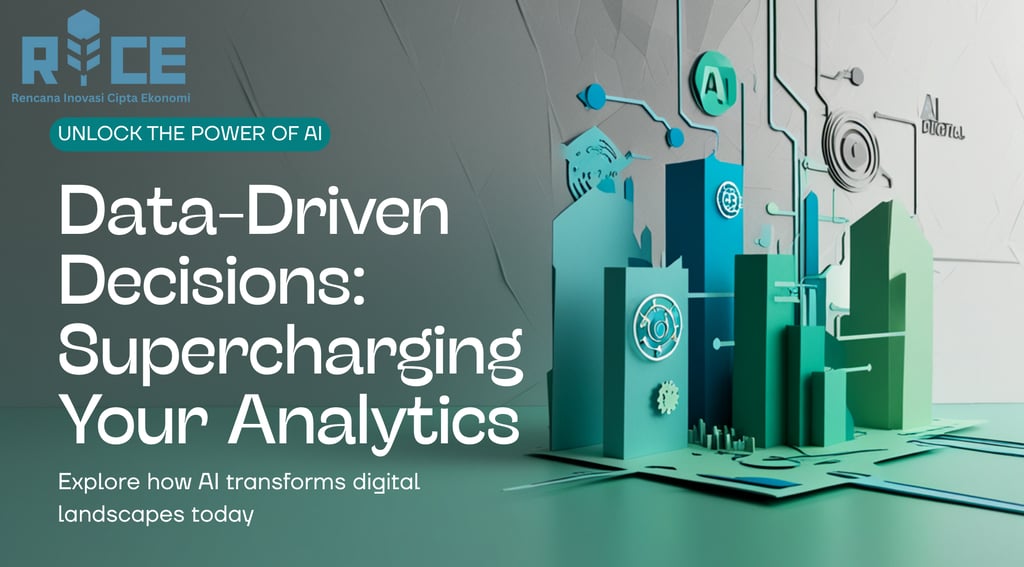Data-Driven Decisions: How Can AI Supercharge Your Digital Transformation Analytics?
Discover how AI transforms digital transformation analytics, shifting from reactive insights to proactive, predictive intelligence for unparalleled business growth.
TECHNOLOGY
Rice AI (Ratna)
10/3/20258 min read


Is your organization truly leveraging its data to drive transformative change? In an era defined by rapid technological advancement and unprecedented data volumes, digital transformation is no longer an option but a strategic imperative. At its core, this transformation hinges on making intelligent, data-driven decisions. However, traditional analytics often struggle to keep pace with the complexity and scale of modern enterprise data. This is precisely where Artificial Intelligence (AI) emerges as a game-changer, poised to supercharge your digital transformation analytics from reactive insights to proactive, predictive intelligence.
The journey of digital transformation demands more than just digitizing existing processes; it requires a fundamental rethinking of how value is created, delivered, and sustained. Data is the fuel for this journey, and analytics is the engine. But without AI, that engine often runs on limited capacity, providing insights that are too late, too shallow, or too siloed. AI offers the power to unlock new dimensions of understanding, automate complex analytical tasks, and elevate decision-making across every facet of your business. This ultimate guide will deep dive into how AI revolutionizes analytics, enabling organizations to navigate their digital future with unparalleled clarity and agility.
The Foundation: Why Traditional Analytics Falls Short in the Digital Age
While foundational, traditional business intelligence and analytics tools, relying heavily on historical data and human interpretation, often hit limitations in the face of today's dynamic environments. The sheer volume and velocity of information, coupled with the need for real-time responsiveness, create gaps that conventional methods struggle to bridge. Understanding these shortcomings is crucial for appreciating AI's transformative potential.
The Data Deluge and Human Limitations
Enterprises today contend with an explosion of data from countless sources: customer interactions, IoT devices, supply chain logistics, social media, and more. Processing, correlating, and extracting meaningful insights from this "data deluge" manually or with basic tools is a monumental, often impossible, task. Human analysts, despite their expertise, are limited in their capacity to process vast datasets quickly and identify subtle patterns or anomalies at scale. This often leads to incomplete analyses or overlooked critical information, hindering truly data-driven decisions.
Latency and Reactive Decision-Making
Traditional analytics typically present a rearview mirror view of performance, reporting on what has already happened. Generating reports, analyzing trends, and deriving conclusions can be time-consuming. This inherent latency means decisions are often reactive, made in response to past events rather than proactively addressing future opportunities or risks. In fast-moving markets, the ability to anticipate and act swiftly is paramount, and a reactive posture can lead to missed opportunities or exacerbated problems.
Siloed Data and Incomplete Insights
Many organizations still grapple with data stored in disparate systems and departments, leading to data silos. This fragmentation prevents a holistic view of the business, as critical correlations between, for instance, marketing spend and operational efficiency might remain hidden. Traditional tools often lack the sophisticated capabilities to seamlessly integrate and normalize data from diverse sources, resulting in partial insights that don't reflect the full organizational context. This incomplete picture can lead to suboptimal decisions based on an inadequate understanding of interconnected business dynamics.
AI as the Accelerator: Core Capabilities for Enhanced Analytics
AI's strength lies in its ability to process, interpret, and learn from data in ways that far exceed human capabilities or traditional algorithms. By embedding AI into your digital transformation analytics strategy, you equip your organization with tools that are not just faster, but fundamentally smarter, delivering deeper, more actionable intelligence.
Automated Data Integration and Preparation
One of the most time-consuming and labor-intensive aspects of analytics is data integration, cleansing, and preparation. AI-powered tools can automate significant portions of this process, intelligently identifying data sources, mapping relationships, detecting and correcting errors, and transforming data into a usable format. Machine learning algorithms can learn data patterns, suggest schemas, and even identify missing values, drastically reducing the "grunt work" and freeing up analysts to focus on higher-value tasks like interpretation and strategy. This automation ensures a cleaner, more consistent foundation for all subsequent analyses.
Advanced Predictive and Prescriptive Analytics
Beyond merely understanding past events, AI excels at foreseeing future outcomes and recommending optimal actions. Predictive analytics uses machine learning models to forecast trends, customer behavior, market shifts, and operational failures with remarkable accuracy. This allows businesses to anticipate demand, identify potential risks, and plan resources more effectively. Prescriptive analytics takes this a step further, not only predicting what will happen but also suggesting the best course of action to achieve desired outcomes or mitigate adverse events, essentially providing data-driven recommendations for future steps.
Natural Language Processing (NLP) for Unstructured Data
A vast amount of valuable business data exists in unstructured formats, such as customer emails, social media comments, call transcripts, legal documents, and feedback forms. Traditional analytics struggles to process this type of qualitative data. Natural Language Processing (NLP), a branch of AI, enables computers to understand, interpret, and generate human language. With NLP, organizations can analyze sentiment from customer reviews, extract key themes from service interactions, or summarize complex documents, turning previously inaccessible insights into actionable intelligence for product development, customer service, and market strategy.
Anomaly Detection and Proactive Risk Management
AI algorithms can continuously monitor vast streams of data, learning what "normal" behavior looks like. This baseline allows them to instantly identify deviations or anomalies that might indicate fraud, cyber threats, operational malfunctions, or unusual market activity. Unlike human-driven monitoring, AI can operate 24/7 across countless data points, catching subtle irregularities that would otherwise go unnoticed until they escalate into significant problems. This capability transforms risk management from a reactive exercise into a proactive defense mechanism, safeguarding assets and ensuring business continuity.
Strategic Applications of AI in Digital Transformation Analytics
The true power of AI in digital transformation analytics becomes evident in its widespread strategic applications across various business functions. By integrating AI, organizations can fundamentally rethink their operations, customer engagement, and innovation cycles, driving significant competitive advantages.
Enhancing Customer Experience and Personalization
AI empowers businesses to deeply understand individual customer preferences, behaviors, and needs. Through AI-driven analytics, companies can analyze interaction history, purchase patterns, browsing behavior, and even sentiment to create highly personalized experiences. This includes tailored product recommendations, customized marketing messages, proactive customer service, and optimized user journeys. The result is increased customer satisfaction, stronger loyalty, and higher conversion rates, turning casual browsers into dedicated advocates.
Optimizing Operational Efficiency
From supply chain management to manufacturing, AI-powered analytics can revolutionize operational efficiency. Predictive maintenance, for example, uses AI to anticipate equipment failures before they occur, reducing downtime and maintenance costs. Logistics optimization leverages AI to find the most efficient routes and schedules, minimizing fuel consumption and delivery times. Workforce analytics can optimize staffing levels and task assignments. By identifying bottlenecks, forecasting resource needs, and automating complex scheduling, AI drives significant cost savings and productivity gains across the entire operational landscape.
Fueling Product Innovation and Development
AI can accelerate the product innovation lifecycle by providing insights into market gaps, emerging trends, and unmet customer needs. By analyzing large datasets of customer feedback, competitor products, and industry trends, AI can help identify features that resonate with users, pinpoint areas for improvement, and even simulate product performance under various conditions. This data-driven approach ensures that new products and services are not only innovative but also precisely aligned with market demand, leading to faster adoption and greater success.
Strengthening Cybersecurity and Fraud Detection
In an increasingly digital world, cybersecurity threats and fraudulent activities are constant concerns. AI-driven analytics are at the forefront of defense. Machine learning models can analyze network traffic, user behavior, and transaction data in real-time to detect anomalous patterns indicative of a cyberattack or fraudulent activity. These systems can learn from new threats, continuously adapting their detection capabilities. This proactive and adaptive security posture is crucial for protecting sensitive data, financial assets, and maintaining customer trust in the digital ecosystem.
Implementing AI for Data-Driven Decisions: A Phased Approach
Embarking on an AI journey for enhanced analytics requires a strategic, phased approach rather than a haphazard dive. Successful implementation involves careful planning, robust infrastructure, and a culture that embraces data and intelligent automation.
Defining Clear Objectives and Use Cases
Before investing in AI technologies, it's critical to define clear business objectives and identify specific use cases where AI can deliver the most impact. Start small with pilot projects that address a clear business problem, demonstrate tangible value, and allow for learning and refinement. Examples include predicting customer churn, optimizing inventory levels, or automating fraud detection. A well-defined objective ensures that AI efforts are aligned with strategic priorities and yield measurable results, building momentum for broader adoption.
Building a Robust Data Infrastructure
AI models are only as good as the data they are trained on. Therefore, a robust, scalable, and well-governed data infrastructure is non-negotiable. This involves implementing modern data warehousing or data lake solutions, establishing data pipelines for efficient ingestion, and ensuring data quality and consistency. Organizations must invest in data governance frameworks to manage data access, security, and compliance. A clean, accessible, and comprehensive data foundation is the bedrock upon which all successful AI analytics initiatives are built.
Cultivating AI Literacy and Talent
The human element remains critical in the age of AI. Organizations need to foster a culture of AI literacy, where employees across departments understand the capabilities and implications of AI. This includes training existing staff in new tools and methodologies, as well as recruiting talent with specialized skills in data science, machine learning engineering, and AI ethics. Bridging the gap between technical AI capabilities and business understanding is vital for driving adoption and ensuring that AI-generated insights are effectively translated into strategic actions.
Choosing the Right AI Tools and Partners
The market for AI tools and platforms is vast and rapidly evolving. Selecting the right technologies—whether it's machine learning platforms, specialized analytics tools, or cloud-based AI services—requires careful evaluation of current needs, future scalability, and integration capabilities. For many organizations, particularly those navigating complex digital transformations, partnering with experienced AI solution providers can accelerate adoption and maximize ROI. For example, Rice AI specializes in delivering tailored AI-powered analytics solutions that integrate seamlessly with existing digital transformation frameworks. Their expertise in advanced machine learning, data orchestration, and predictive intelligence empowers businesses to move beyond descriptive analytics, providing actionable foresight crucial for competitive advantage. Such partnerships can help demystify the complexities of AI, ensuring that your analytics capabilities are truly supercharged.
Challenges and Overcoming Them in AI Analytics Adoption
While the promise of AI in analytics is immense, its implementation is not without challenges. Addressing these proactively is essential for a smooth and successful digital transformation journey.
Data Quality and Governance
As mentioned, AI thrives on high-quality data. Poor data quality – characterized by incompleteness, inconsistencies, or inaccuracies – can lead to biased models and flawed insights, undermining the entire analytics effort. Establishing strong data governance policies, investing in data cleansing tools, and fostering a data-first culture are critical. This involves defining data ownership, establishing clear data standards, and implementing continuous monitoring to ensure the integrity and reliability of data used by AI systems.
Ethical AI and Bias Mitigation
AI models learn from the data they are fed, and if that data contains historical biases, the AI can perpetuate or even amplify those biases. This raises significant ethical concerns, especially in areas like hiring, lending, or customer profiling. Organizations must be vigilant in identifying and mitigating bias in their data and algorithms. This involves diverse data collection, transparent model development, continuous monitoring for fairness, and adopting ethical AI guidelines. Prioritizing fairness, accountability, and transparency is paramount for building trust and ensuring responsible AI deployment.
Scalability and Integration Hurdles
Integrating new AI systems with legacy IT infrastructure can be complex and challenging. Ensuring that AI analytics platforms can scale to handle growing data volumes and evolving business needs is also a critical consideration. Poor integration can lead to operational bottlenecks, data inconsistencies, and a fragmented analytical landscape. Planning for robust APIs, modular architectures, and cloud-native solutions can help overcome these hurdles, ensuring that AI capabilities are seamlessly embedded into the enterprise's broader digital ecosystem and can grow alongside the business.
Conclusion: The Future of Data-Driven Leadership
The convergence of digital transformation and Artificial Intelligence marks a pivotal moment for businesses seeking to thrive in the modern economy. Traditional analytics, while valuable, can no longer fully address the complexity, velocity, and sheer volume of data confronting today's enterprises. AI steps in as the ultimate accelerator, transforming analytics from a historical reporting function into a predictive, prescriptive, and profoundly strategic capability.
By embracing AI, organizations unlock the power of automated data preparation, advanced predictive modeling, and the ability to derive insights from previously inaccessible unstructured data. This translates directly into enhanced customer experiences, optimized operational efficiencies, accelerated product innovation, and fortified cybersecurity defenses. The journey involves strategic planning, a commitment to data quality, fostering AI literacy, and selecting the right technological partners.
The future belongs to data-driven leaders who leverage AI not just as a tool, but as a core pillar of their digital strategy. It’s about moving beyond understanding what happened to predicting what will happen, and ultimately, prescribing the best path forward. Are you ready to supercharge your digital transformation analytics and unlock unparalleled strategic advantage? The time to embed AI into the fabric of your decision-making is now.
To explore how tailored AI analytics solutions can elevate your digital transformation efforts, reach out to Rice AI today. Our experts are ready to guide you through unlocking the full potential of your data.
#AIAnalytics #DigitalTransformation #DataDrivenDecisions #MachineLearning #PredictiveAnalytics #BusinessIntelligence #EnterpriseAI #DataStrategy #AIImplementation #FutureOfWork #AIforBusiness #SmartAnalytics #Innovation #DigitalStrategy #BigData #DailyAITechnology
RICE AI Consultant
To be the most trusted partner in digital transformation and AI innovation, helping organizations grow sustainably and create a better future.
Connect with us
Email: consultant@riceai.net
+62 822-2154-2090 (Marketing)
© 2025. All rights reserved.


+62 851-1748-1134 (Office)
IG: @riceai.consultant
